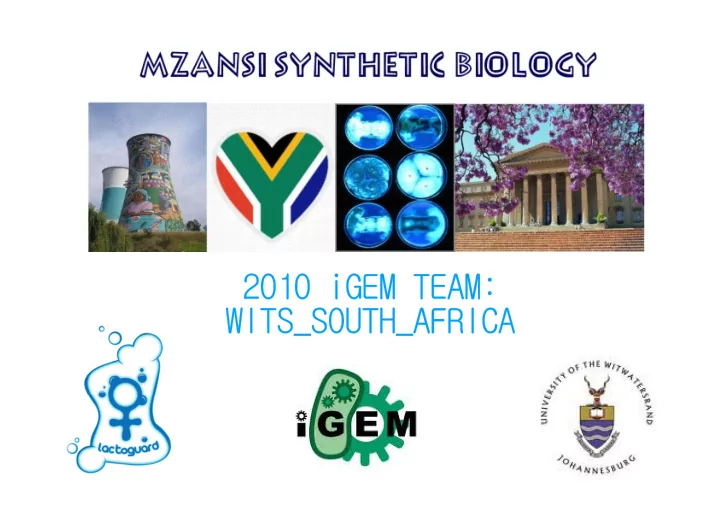

Team Wits South Africa • Multi-disciplinary team • 6 students from various faculties – Molecular Medicine and Haematology – Molecular and Cell Biology – Chemical Engineering – Computational and Applied Mathematics – Philosophy • Sponsored and supported by Wits University, the South African Council for Scientific and Industrial Research
The Problem • Cervical cancer is the second most prevalent cancer in women worldwide and the cause of 250 000 deaths every year • It is caused exclusively by Human Papillomavirus - the most common STI in the world! • 85% of women… • HPV infects mucosal skin cells with a high rate of cellular turnover • In most cases the body’s immune system recognises the infection and is able to clear it effectively. But what if it doesn’t….? • HPV is especially problematic in the developing world where access to regular health care is limited
Detection and Diagnosis • There is no antiviral or cure for HPV infection • The only diagnostic for HPV (the Pap smear) does not detect the virus itself - will only detect an infection if it has actually progressed to cancer! • A Pap smear can detect the pathology very (if not too) late • PCR can also be used to detect viral DNA – this is the current gold standard for HPV diagnosis but is strain specific and impractical to implement on a wide scale at this point • Need technology that is – Affordable – Easy to implement and use – Immediate – Possibly protective?
Introducing Lactoguard • Whole-cell biosensor for the immediate, in vivo detection of Human Papillomavirus (HPV) • Engineered commensal vaginal bacterium ( Lactobacillus gasseri ) • Intended primarily for women in resource-poor settings • Will alert an infected individual that they have been exposed
Introducing Lactoguard • Our machine will be created to respond to a stimulus and produce a visual output • The sensing and response components will be in different bacterial cells • The different bacterial cells will communicate with each other • The visual response can thus be propagated throughout a bacterial population Population 1 in Population 2 in HPV Lactobacillus gasseri Lactobacillus gasseri infection Chromogenic Quorum reporter Machine 1- Machine 2- “Lacto-detect” “Lacto-test”
Machine Design
Mathematic Modelling • Saves valuable resources. Every revision of the machine need not be built • Allows insights into what biology may or may not work, aiding in the selection of biological components • Investigate feedback mechanism to analyse the stability of our system
Block Diagram • Intracellular model • Extracellular model • Intercellular model
Model
Machine construction “Lacto-detect” “Lacto-test”
Machine testing • Combined two populations of bacteria: – IPTG inducible Lacto-detect (in E.coli ) – Lacto-test (in B.subtilis ) • Wanted to test whether B.subtilis could process and import the foreign quorum peptide, and use it to activate transcription of mCherry • Testing was done via fluorescence spinning disk confocal microscopy
Results 0 30 60 90 120 150 mCherry Venus 180 210 240 270 300 330 mCherry Venus
Human Advances • We conducted a theoretical exercise examining some expected ethical problems with the possible implementation of our device in a rural African context • We wanted to use this case study to achieve to aims: 1. To introduce Ubuntu as an ethical theory to the scientific community 2. To show that Ubuntu is coherent
What is Ubuntu? • Ubuntu is a moral theory of African origin • We used T Metz’s definition: An action is right just insofar as it produces harmony and reduces discord; an act is wrong to the extent that it fails to develop community
• There is a clear need to engage in dialogue and debate on ethical issues. The question is how? • Ubuntu lays out ground rules for how this debate will work 1. Communal relations are important. We all belong to a community. Our ethical conduct is shaped by our community and is fundamental to all ethical action 2. Debate should be continuous and inclusive as possible. It is the process of debate, not simply the conclusions we reach that is of ethical importance 3. We should consider the wellbeing of those in our community. We have an obligation to them in light of relation to them
Thank you…
Recommend
More recommend